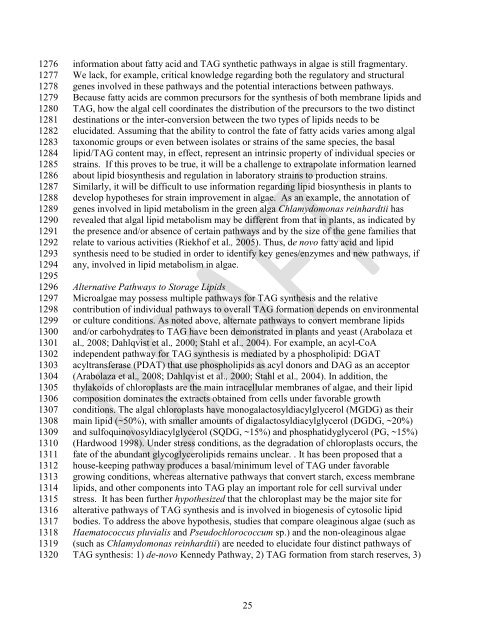Download the Algal Biofuels Roadmap draft document - Sandia
Download the Algal Biofuels Roadmap draft document - Sandia
Download the Algal Biofuels Roadmap draft document - Sandia
Create successful ePaper yourself
Turn your PDF publications into a flip-book with our unique Google optimized e-Paper software.
1276<br />
1277<br />
1278<br />
1279<br />
1280<br />
1281<br />
1282<br />
1283<br />
1284<br />
1285<br />
1286<br />
1287<br />
1288<br />
1289<br />
1290<br />
1291<br />
1292<br />
1293<br />
1294<br />
1295<br />
1296<br />
1297<br />
1298<br />
1299<br />
1300<br />
1301<br />
1302<br />
1303<br />
1304<br />
1305<br />
1306<br />
1307<br />
1308<br />
1309<br />
1310<br />
1311<br />
1312<br />
1313<br />
1314<br />
1315<br />
1316<br />
1317<br />
1318<br />
1319<br />
1320<br />
information about fatty acid and TAG syn<strong>the</strong>tic pathways in algae is still fragmentary.<br />
We lack, for example, critical knowledge regarding both <strong>the</strong> regulatory and structural<br />
genes involved in <strong>the</strong>se pathways and <strong>the</strong> potential interactions between pathways.<br />
Because fatty acids are common precursors for <strong>the</strong> syn<strong>the</strong>sis of both membrane lipids and<br />
TAG, how <strong>the</strong> algal cell coordinates <strong>the</strong> distribution of <strong>the</strong> precursors to <strong>the</strong> two distinct<br />
destinations or <strong>the</strong> inter-conversion between <strong>the</strong> two types of lipids needs to be<br />
elucidated. Assuming that <strong>the</strong> ability to control <strong>the</strong> fate of fatty acids varies among algal<br />
taxonomic groups or even between isolates or strains of <strong>the</strong> same species, <strong>the</strong> basal<br />
lipid/TAG content may, in effect, represent an intrinsic property of individual species or<br />
strains. If this proves to be true, it will be a challenge to extrapolate information learned<br />
about lipid biosyn<strong>the</strong>sis and regulation in laboratory strains to production strains.<br />
Similarly, it will be difficult to use information regarding lipid biosyn<strong>the</strong>sis in plants to<br />
develop hypo<strong>the</strong>ses for strain improvement in algae. As an example, <strong>the</strong> annotation of<br />
genes involved in lipid metabolism in <strong>the</strong> green alga Chlamydomonas reinhardtii has<br />
revealed that algal lipid metabolism may be different from that in plants, as indicated by<br />
<strong>the</strong> presence and/or absence of certain pathways and by <strong>the</strong> size of <strong>the</strong> gene families that<br />
relate to various activities (Riekhof et al., 2005). Thus, de novo fatty acid and lipid<br />
syn<strong>the</strong>sis need to be studied in order to identify key genes/enzymes and new pathways, if<br />
any, involved in lipid metabolism in algae.<br />
Alternative Pathways to Storage Lipids<br />
Microalgae may possess multiple pathways for TAG syn<strong>the</strong>sis and <strong>the</strong> relative<br />
contribution of individual pathways to overall TAG formation depends on environmental<br />
or culture conditions. As noted above, alternate pathways to convert membrane lipids<br />
and/or carbohydrates to TAG have been demonstrated in plants and yeast (Arabolaza et<br />
al., 2008; Dahlqvist et al., 2000; Stahl et al., 2004). For example, an acyl-CoA<br />
independent pathway for TAG syn<strong>the</strong>sis is mediated by a phospholipid: DGAT<br />
acyltransferase (PDAT) that use phospholipids as acyl donors and DAG as an acceptor<br />
(Arabolaza et al., 2008; Dahlqvist et al., 2000; Stahl et al., 2004). In addition, <strong>the</strong><br />
thylakoids of chloroplasts are <strong>the</strong> main intracellular membranes of algae, and <strong>the</strong>ir lipid<br />
composition dominates <strong>the</strong> extracts obtained from cells under favorable growth<br />
conditions. The algal chloroplasts have monogalactosyldiacylglycerol (MGDG) as <strong>the</strong>ir<br />
main lipid (~50%), with smaller amounts of digalactosyldiacylglycerol (DGDG, ~20%)<br />
and sulfoquinovosyldiacylglycerol (SQDG, ~15%) and phosphatidyglycerol (PG, ~15%)<br />
(Hardwood 1998). Under stress conditions, as <strong>the</strong> degradation of chloroplasts occurs, <strong>the</strong><br />
fate of <strong>the</strong> abundant glycoglycerolipids remains unclear. . It has been proposed that a<br />
house-keeping pathway produces a basal/minimum level of TAG under favorable<br />
growing conditions, whereas alternative pathways that convert starch, excess membrane<br />
lipids, and o<strong>the</strong>r components into TAG play an important role for cell survival under<br />
stress. It has been fur<strong>the</strong>r hypo<strong>the</strong>sized that <strong>the</strong> chloroplast may be <strong>the</strong> major site for<br />
alterative pathways of TAG syn<strong>the</strong>sis and is involved in biogenesis of cytosolic lipid<br />
bodies. To address <strong>the</strong> above hypo<strong>the</strong>sis, studies that compare oleaginous algae (such as<br />
Haematococcus pluvialis and Pseudochlorococcum sp.) and <strong>the</strong> non-oleaginous algae<br />
(such as Chlamydomonas reinhardtii) are needed to elucidate four distinct pathways of<br />
TAG syn<strong>the</strong>sis: 1) de-novo Kennedy Pathway, 2) TAG formation from starch reserves, 3)<br />
25


